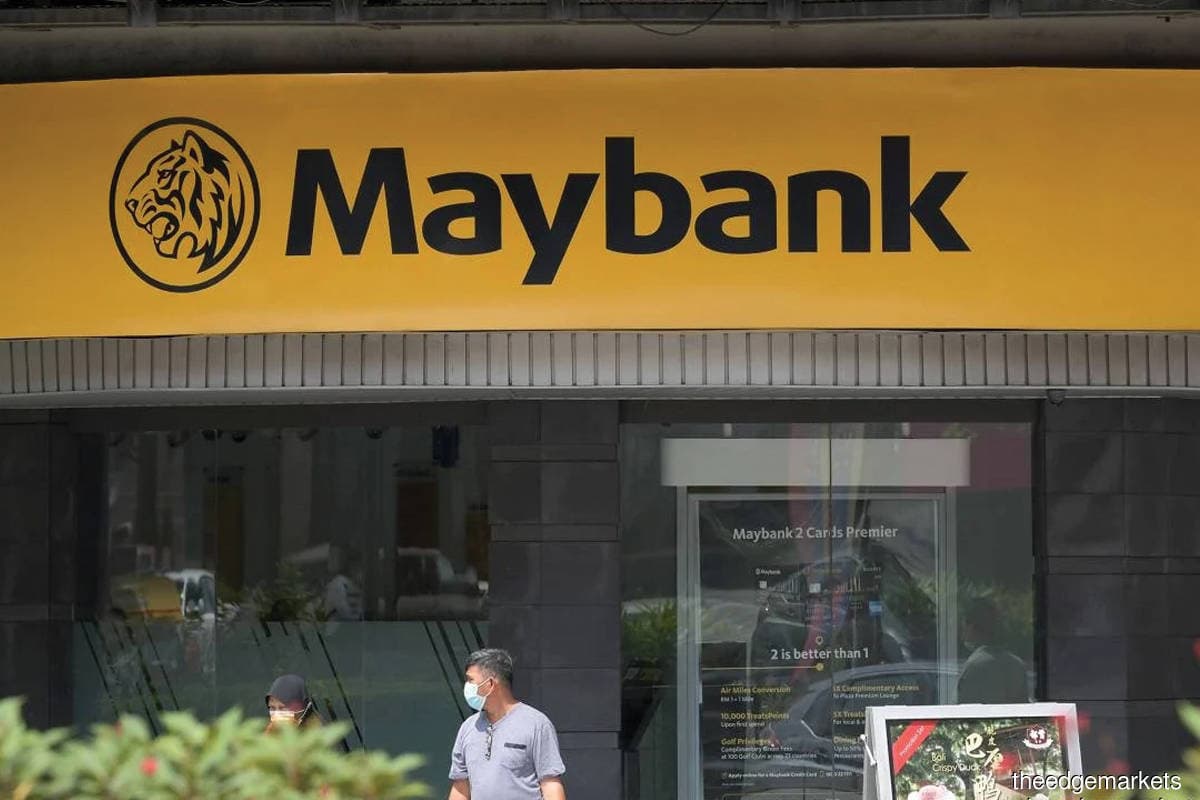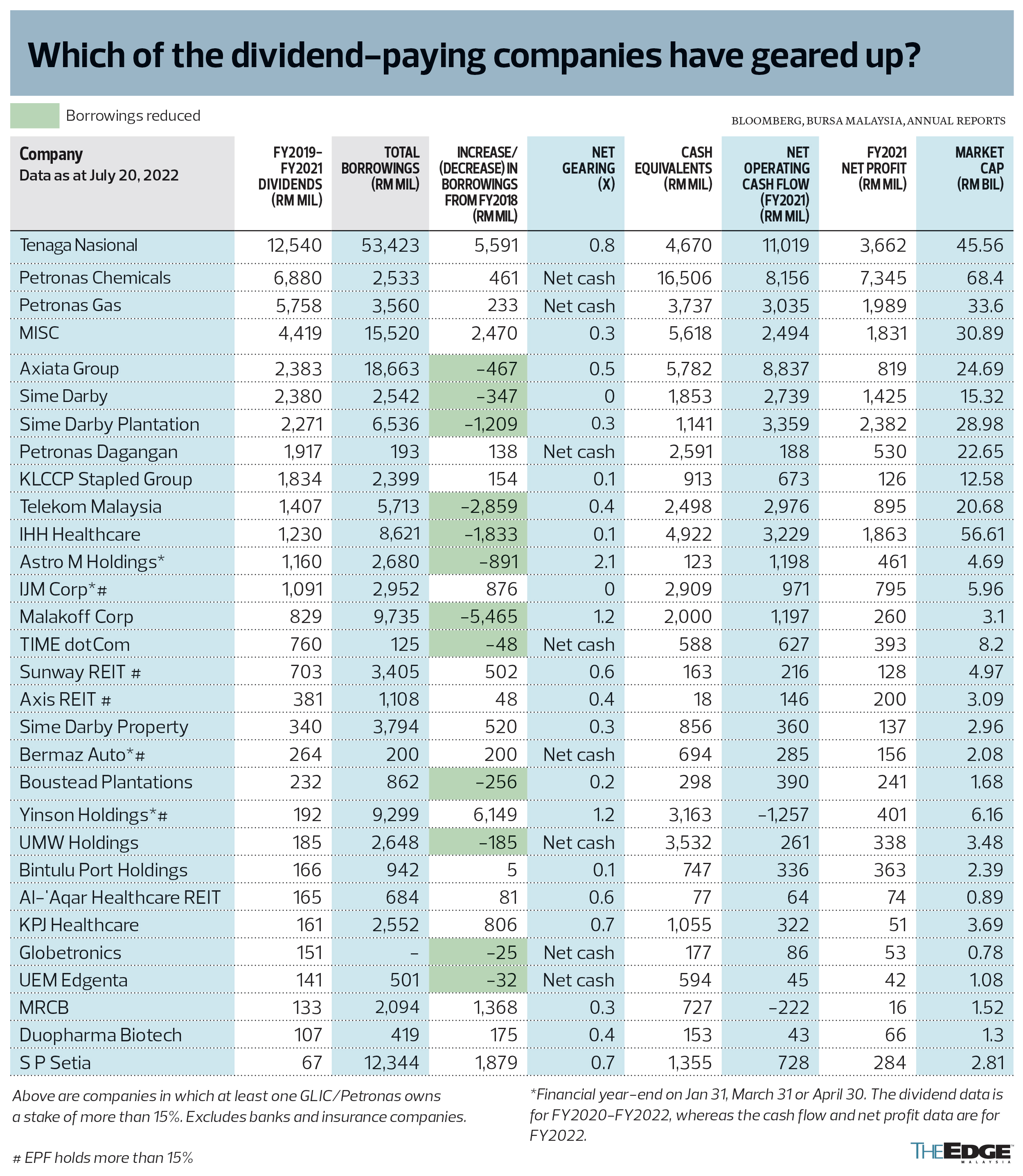
This article first appeared in The Edge Malaysia Weekly on July 25, 2022 - July 31, 2022
IN 2021, although it was the peak of the Covid-19 pandemic, which caused massive disruptions to the global economy, public-listed companies — in which either the government or public funds hold more than 15% equity interest — continued to reward their shareholders with generous dividends.
Surprisingly, some even paid higher dividends year on year instead of conserving cash during the harsh economic conditions (see tables).
The generous dividends will undoubtedly come in handy for the shareholders when cash flow is tight, if not stretched, in the current challenging period.
Malayan Banking Bhd (Maybank), in which Permodalan Nasional Bhd holds a 41.1% stake, kept its dividend payout ratio at above 80% in the past three years. The banking group dished out total dividends of RM19.94 billion for the three-year period between 2019 and 2021 — probably the highest total dividends paid by a Bursa Malaysia-listed company during that period.
The RM19.94 billion total dividends was more than double the RM8.3 billion that Public Bank Bhd — another bank known for paying regular dividends — declared, according to annual reports. It is worth noting that the Employees Provident Fund (EPF) is the second largest shareholder of Public Bank with a 15.2% stake, after founder Tan Sri Teh Hong Piow, who has 23.41%.
RHB Bank, in which EPF has a 42.14% shareholding, raised its payout ratio to 63% in the financial year ended Dec 31, 2021 (FY2021), from 35% in FY2020 and 50% in FY2019. RHB Bank paid out RM1.64 billion in FY2021, a jump from RM708 million in FY2020 and RM1.243 billion in FY2019.
The dividend payout ratio at Malaysia Building Society Bhd (MBSB), in which EPF is the controlling shareholder as well with a 65.7% stake, increased its dividend payout ratio to 81% in FY2021, or RM355 million, up from 75% in FY2020 (RM201 million) and 45% (RM320 million) in FY2019. The financial group declared total dividends of RM876 million for the past three financial years.
CIMB Group Bhd, in which Khazanah Nasional Bhd holds a 25.72% stake and the EPF 15.32%, is the third most generous among the Bursa-listed banks. The banking group paid out a total of RM5.35 billion in the past three financial years, RM2.55 billion (26 sen per share) in FY2019, RM477 million (4.8 sen per share) in FY2020 and RM2.32 billion (22.99 sen per share) in FY2021.
Tenaga Nasional Bhd is probably the dark horse. For the past three financial years, the utility group declared RM12.54 billion total dividends — the second highest among the companies whose substantial shareholders are either government-controlled entities or public funds. Tenaga’s dividend payout ratio soared to 126% and 127% in FY2019 and FY2020, with dividends of 80 sen (including a special dividend of 40 sen) and RM1 (including a special dividend of 50 sen) respectively. Khazanah Nasional Bhd has a 25.58% stake in Tenaga, while EPF holds 16.02%, Amanah Saham Bumiputra has 9.73%, and Kumpulan Wang Persaraan (Diperbadankan) (KWAP), 7.32%.
It is worth noting that while Tenaga has been declaring generous dividends, its borrowings have also climbed higher. The group’s total borrowings have gone up by RM5.59 billion over the past three years to RM53.4 billion as at end-2021.
IJM Corp Bhd shareholders are among those laughing all the way to the bank after the pleasant surprise of a special dividend paid on Dec 30, 2021. The construction giant declared a 15 sen special dividend per share that month after the disposal of its stake in IJM Plantations Bhd.
For its financial year ended March 31, 2022, IJM Corp declared a first interim dividend of two sen and a second interim dividend per share of four sen, in addition to the special dividend. In total, the group paid out RM766 million in dividends for that financial year, in which both of its substantial shareholders — Amanah Saham Nasional Bhd (17.31%) and EPF (17.05%) — were expected to receive roughly RM130 million each.
Both Axis Real Estate Investment Trust (Axis REIT) and Bermaz Auto Bhd are on the list under review as the EPF is their single largest shareholder, holding stakes of 16.03% and 18.26% respectively.
The two companies managed to continue their dividend payments despite the harsh operating environment.
For the financial year ended April 30, 2022, Bermaz paid out a special dividend of 2.5 sen, bringing the total dividend per share declared to 8.75 sen or RM102 million. The auto maker dished out 6.50 sen dividend per share in FY2021 and 7.45 sen per share in FY2020. A back-of-the-envelope calculation shows that Bermaz rewarded shareholders with total dividends of RM264 million between FY2020 and FY2022.
Axis REIT declared RM381 million in total dividends over the three financial years from Dec 31, 2019, to Dec 31, 2021. Its payout ratio increased to a high of 89% in FY2020 from 56% in FY2019. Its ratio was 69% in FY2021.
Among the Petronas-owned listed entities, Petronas Chemicals Group Bhd declared the highest dividend and is ranked fourth on the review list. The downstream petrochemical player, which has a net cash pile of RM12 billion, paid out a total of RM6.88 billion for the three financial years between FY2019 and FY2022, with payout ratios ranging from 51% to 61%.
Although sister company Petronas Gas Bhd (PetGas) paid RM5.75 billion, which was less than PetChem’s payout, its payout ratio was a lot higher at above 80% in the three years under review. The ratio reached 125% in FY2020. Nonetheless, PetGas is also in a net cash position.
Petronas’ shipping arm MISC Bhd declared total dividends of RM4.41 billion over the past three financial years with a consistent annual dividend of RM1.47 billion, although it slipped into the red in FY2020.
Petronas Dagangan Bhd’s dividend payout ratio exceeded 100% for the three years under review with total dividends amounting to RM1.91 billion. The ratio was at 102% in FY2019, 137% in FY2020 and 131% in FY2021. Likewise, the group also declared a special dividend of 15 sen per share in FY2019, bringing total dividend per share to 85 sen.
The five public-listed entities in which Petronas holds a controlling stake, namely PetChem, PetGas, MISC, PetDag and KLCCP Staple Group, collectively declared total dividends of RM20.78 billion in the past three financial years.
Dr Yeah Kim Leng, professor of economics at Sunway University Business School, points out that the National Budget 2022 estimated that the government would receive RM39.5 billion, including a RM25 billion contribution from Petronas, as interest income, dividends and return on investments, which is an increase from RM36 billion in 2021.
Dividends and return on investment made up about 16% of public revenue in 2021, says Yeah. “Given that the average price of the Tapis blend crude oil in the first five months has increased by slightly over 25% from last year’s average price, Petronas’ dividend therefore can potentially rise by an additional RM5 billion.
“Dividends from the national oil firm Petronas, Khazanah and other government-linked companies are expected to be higher this year on account of higher crude oil and gas prices and increased earnings due to stronger economic growth,” Yeah comments.
He notes that as long as the dividend payments do not disrupt capital investment plans and worsen the capital structure of the public-listed enterprises or government-linked companies, such dividend contributions help to enhance public financial management and the country’s fiscal stability.
Malaysian Institute of Economic Research (MIER) senior fellow Dr Shankaran Nambiar concurs that GLCs could be tapped for their dividends as an alternative source of non-tax revenue.
However, he cautions that this might not be a “totally reliable” revenue source. Furthermore, bumper dividends are unlikely to be sustainable, particularly in circumstances when the payout ratio exceeds 100%.
“When a company’s dividend payout ratio is more than 100%, it is paying out dividends in excess of income. This is not sustainable and the company will have to cut down on such generous payoffs.
“Secondly, as the economy shifts into lower gear, as it would when we encounter more challenging circumstances, companies’ dividend payouts will drop,” Nambiar comments, noting that it will be detrimental to companies if their balance sheets are overstretched due to excessive dividend payments.
Save by subscribing to us for your print and/or digital copy.
P/S: The Edge is also available on Apple's AppStore and Androids' Google Play.

